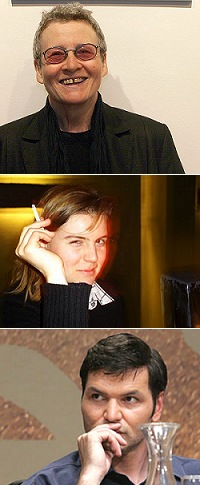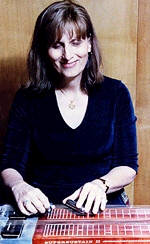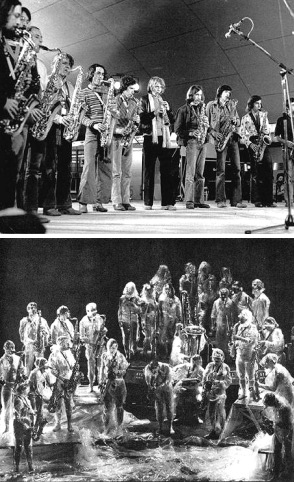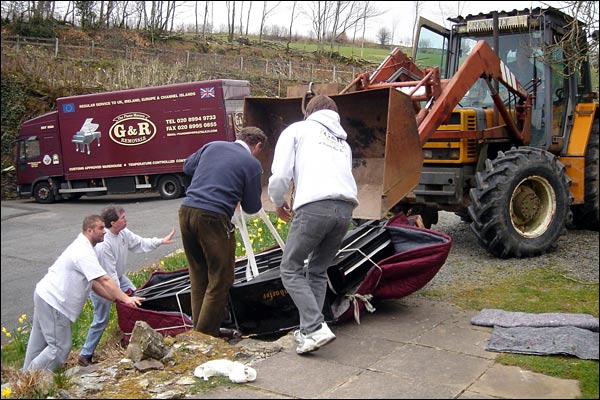Our regular listen to and look at living, breathing composers and performers that you may not know yet, but I know you should… And can, right here and now, with so much good listening online.
Time to leave our standard classical composers and performers behind for a second, to hear what the writers can do:
Liesl Ujvary – Ann Cotten – Hanno Millesi (Austria): “Ghostengine – Speech without Language” (2005)
 Liesl Ujvary (1939-, Pressburg/Slovakia) moved to Austria in 1945 and spent her childhood in Lower Austria and Tyrol. She studied Slavonic, old-Hebrew literature and art history in Vienna and Zurich. After some visits in Moscow she finished her dissertation on Ilja Ehrenburg’s ‘Julio Jurenito’ at the University in Zurich in 1968. She held a university teaching position for Russian language and literature at the Sophia University in Tokyo, and lives as a writer in Vienna since 1971.
Liesl Ujvary (1939-, Pressburg/Slovakia) moved to Austria in 1945 and spent her childhood in Lower Austria and Tyrol. She studied Slavonic, old-Hebrew literature and art history in Vienna and Zurich. After some visits in Moscow she finished her dissertation on Ilja Ehrenburg’s ‘Julio Jurenito’ at the University in Zurich in 1968. She held a university teaching position for Russian language and literature at the Sophia University in Tokyo, and lives as a writer in Vienna since 1971.
Ann Cotten (1982-) was born in Iowa, but her family moved to Austria when she was five. After growing up in Vienna, she just moved to Berlin last year, having stirred up a raft of critical attention with her first book of poetry, Fremdwörterbuchsonette (“Foreign Dictionary Sonnets”). The Frankfurter Rundschau interviewed her recently, and an English version of that article can be read at Sign and Sight.
Hanno Millesi (1966-, Vienna) studied art history in Vienna and Graz. From 1986-1992 he worked with Galerie Krinzinger in Vienna; from 1992 to 1999 assisted Hermann Nitsch’s “Orgien Mysterien Theaters”; 1999-2001 hung out at the Museum Moderner Kunst Stiftung Ludwig Wien; all the while working at his own writing (as well as his guitar, in the band ALBERS).
— OK, preliminaries out of the way, why tell you about these three Austrian writers on our trusty new-music site? Because among Ujvary’s kalideoscopic interests and activities is music and sound art, which for the last ten-plus years she’s been broadcasting on radio and issuing on CD. The link on her name above will take you to her main website; from there the “musik” button will send you to a whole compendium of these, most available as free MP3 downloads as well as standard CDs. But clicking the other link above this post will take you directly to the 2005 CD Ghostengine – Sprechen ohne Sprach (“speech without language”). In this essay Ujvary, Cotten and Millesi all interact with an Etherwave theremin, trying to create a a kind of intuitive, wordless “speech”. Ujvary also processes this using a Kaoss pad — a wonderfully fun device from Korg, that lets you control all kinds of processing in realtime, with a few movements of your fingers. Interleaved between the solo “speeches” are four mixes by Ujvary, where she combines, varies and elaborates the three solos.
Mahler it most certainly is NOT; but it is a wonderful soundscape, that somehow captures a bit of each of its collaborators.

 Susan plays a quintessential Texas instrument, the pedal steel guitar. She spent a lot of years paying her dues and perfecting her technique in Country bands, but some part of her always hankered after things more adventurous. I’ll let her pick up the story:
Susan plays a quintessential Texas instrument, the pedal steel guitar. She spent a lot of years paying her dues and perfecting her technique in Country bands, but some part of her always hankered after things more adventurous. I’ll let her pick up the story: Urban Sax is a long-running ensemble / musical extravaganza founded by the French musician Gilbert Artman. It was was formed in 1973, when Artman organized a concert by a group of eight saxophonists at a classical music festival in the south of France. In subsequent years, the number of players grew to 12, 20, 30, and by now consists of 52 musicians (with saxophones ranging from the soprano to bass registers). Artman frequently integrates local musicians and dancers into his performances, and thus the ensemble can encompass as many as 200 performers.
Urban Sax is a long-running ensemble / musical extravaganza founded by the French musician Gilbert Artman. It was was formed in 1973, when Artman organized a concert by a group of eight saxophonists at a classical music festival in the south of France. In subsequent years, the number of players grew to 12, 20, 30, and by now consists of 52 musicians (with saxophones ranging from the soprano to bass registers). Artman frequently integrates local musicians and dancers into his performances, and thus the ensemble can encompass as many as 200 performers.
 Next to the Mountaineers winning the NIT (okay, so it’s the tournament of losers…we won), the most exciting news in the world today is that our lil’ buddy Ian Moss is having his second annual
Next to the Mountaineers winning the NIT (okay, so it’s the tournament of losers…we won), the most exciting news in the world today is that our lil’ buddy Ian Moss is having his second annual